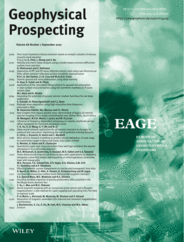
Full text loading...
 , Roberto G. Oliveira5
, Roberto G. Oliveira5
Severe limitations of the standard Euler deconvolution to outline source shapes have been pointed out. However, Euler deconvolution has been widely employed on field data to outline interfaces, as faults and thrust zones. We investigate the limitations of the 3D Euler deconvolution–derived estimates of source dip and volume with the use of reduced‐to‐the‐pole synthetic and field anomalies. The synthetic anomalies are generated by two types of source bodies: (1) uniformly magnetized prisms, presenting either smooth or rough interfaces, and (2) bodies presenting smooth delimiting interfaces but strong internal variation of magnetization intensity. The dip of the first type of body might be estimated from the Euler deconvolution solution cluster if the ratio between the depth to the top and vertical extent is relatively high (>1/4). For the second type of body, besides dip, the source volume can be approximately delimited from the solution cluster envelope, regardless of the referred ratio. We apply Euler deconvolution to two field anomalies which are caused by a curved‐shape thrust zone and by a banded iron formation. These anomalies are chosen because they share characteristics with the two types of synthetic bodies. For the thrust zone, the obtained Euler deconvolution solutions show spatial distribution allowing to estimate a source dip that is consistent with the surface geology data, even if the above‐mentioned ratio is much less than 1/4. Thus, there are other factors, such as a heterogeneous magnetization, which might be controlling the vertical spreading of the Euler deconvolution solutions in the thrust zone. On the other hand, for the iron‐ore formation, the solution cluster spreads out occupying a volume, in accordance with the results obtained with the synthetic sources having internal variation of magnetization intensity. As conclusion, although Euler deconvolution–derived solutions cannot offer accurate estimates of source shapes, they might provide a sufficient degree of reliability in the initial estimates of the source dip and volume, which may be useful in a later phase of more accurate modelling.

Article metrics loading...

Full text loading...
References


Data & Media loading...

